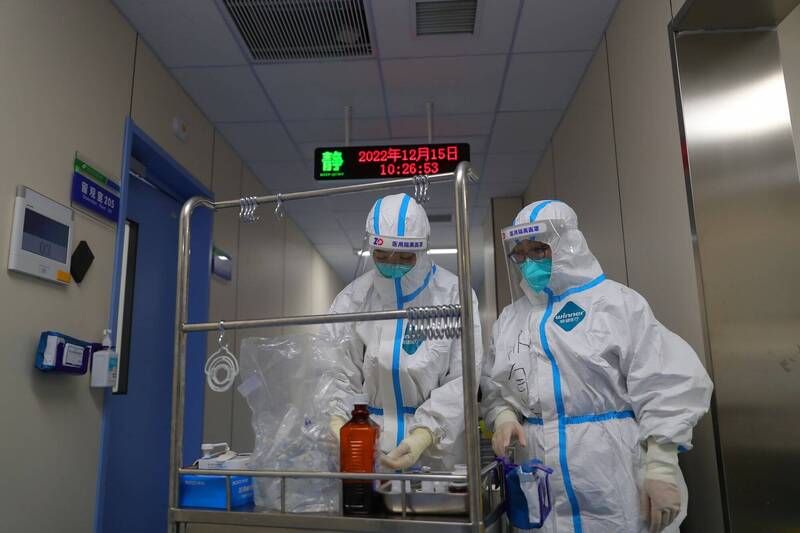Medical staff work at the fever clinic of Shengjing Hospital of China Medical University in Shenyang, northeast China's Liaoning province.
(European News Agency)
[Central News Agency] Many major cities in China have announced that they have passed the peak of the epidemic, but the three northeastern provinces with relatively backward medical resources are still struggling. Local doctors say that the biggest problem is the lack of medicines. "It's like you go to war without weapons." In some counties Doctors in top-level hospitals will not use ventilators.
China News Weekly published a report on its WeChat public account today, pointing out that in the vast and cold northeastern region, the peak of infections and severe cases is almost at the same time as Beijing, but few people pay attention.
Please read on...
The report quoted the director of the emergency department of a tertiary hospital in Jilin Province as saying that the main problem in the fight against the epidemic in the Northeast is the lack of medicines. In the early days, even antipyretics could not be prescribed, and now there is only a small supply of Paxlovid, Azvudine Not enough either.
Zhang Wenhong, an infectious disease expert in Shanghai, mentioned that there are "golden 72 hours" after COVID-19 infection. If patients can be given antiviral treatment within 3 days after infection, and supplemented with hormone therapy, most patients will be relieved. .
But the Northeast doctor said that this is a very idealistic idea, which is difficult to achieve in the Northeast.
Because in the first few weeks before the peak of severe cases, they had almost no antiviral drugs, as if "going to war without weapons."
According to the report, until the beginning of January, it was still difficult for hospitals to prescribe the antiviral drug Belavide. In order to treat patients, some doctors even purchased generic drugs from Laos to relieve the urgent need.
Until the last week, the shortage of medicines has not eased.
The doctor said that "prevention of severe illness" is more important than "treatment of severe illness". They have already developed into severe illness with multiple organ failure, and it is difficult to treat them again.
She is most worried about a wave of infections in rural areas in the next few weeks, especially after many migrant workers return to their hometowns during the Spring Festival, which may trigger a second wave of shocks.
The basic medical conditions in the three northeastern provinces are relatively backward. County-level hospitals lack treatment measures for "severe disease prevention", and some doctors do not know how to use ventilators, which may delay the intervention of patients. As a result, they may develop severe diseases and eventually be referred to higher-level hospitals. , to the cities, again putting pressure on the healthcare system.
According to her, the peak of severe cases in Jilin will begin to appear around December 16-17, 2022, and it is still in the plateau period so far, and it is not expected to end soon.
Many elderly people with chronic diseases have a strong sense of self-protection and do not go out at the beginning of the relaxation of epidemic prevention.
But as time went on, these high-risk groups also began to be infected one after another.
In recent weeks, among the critically ill COVID-19 patients admitted to the emergency department, elderly people in their 80s and 90s accounted for an increasing proportion, and many of them did not get a single shot.
In addition, many Northeast people suffer from emphysema, which tends to worsen in winter, she said, because of the cold winters in the Northeast.
These patients' original lung function was not very good, and after being infected with COVID-19, they quickly developed severe illness, which is very common in Northeast China.
The report quoted a calculation by the School of Public Health of Fudan University. In 2021, Beijing and Shanghai will have the highest number of comprehensive ICU beds per 100,000 permanent residents in China, with 6.25 and 6.14 ICU beds per 100,000 population respectively. The number of comprehensive ICU beds is only 2.78, less than half of that in Beijing.
Related news please see:
Please click here for the "Wuhan Pneumonia Zone", for more information, you can grasp it first-hand.
The director of the emergency department of a tertiary hospital in Jilin Province said that the main problem in the fight against the epidemic in the Northeast is the lack of medicines. In the early days, even antipyretics could not be prescribed, and now there is only a small supply of Paxlovid.
(Reuters)
